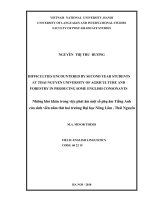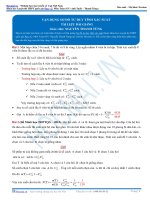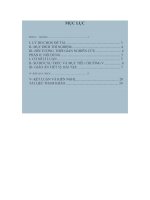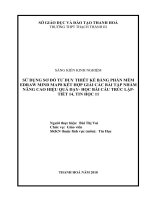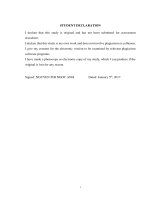Using mind mapping to help students at Thanh Hoa College of Agriculture and Forestry recycle vocabulary = Sử dụng sơ đồ tư duy để giúp sinh viên ở Trường Trung
Bạn đang xem bản rút gọn của tài liệu. Xem và tải ngay bản đầy đủ của tài liệu tại đây (1.8 MB, 60 trang )
VIETNAM NATIONAL UNIVERSITY, HANOI
UNIVERSITY OF LANGUAGES AND INTERNATIONAL STUDIES
FACULTY OF POST - GRADUATE STUDIES
*********
LƯU VĂN HẬU
USING MIND MAPPING TO HELP STUDENTS AT THANH HOA
COLLEGE OF AGRICULTURE AND FORESTRY RECYCLE
VOCABULARY
(SỬ DỤNG SƠ ĐỒ TƯ DUY ĐỂ GIÚP SINH VIÊN Ở TRƯỜNG TRUNG CẤP
NÔNG LÂM THANH HÓA TÁI SỬ DỤNG TỪ VỰNG)
M.A. MINOR PROGRAMME THESIS
Field: English Teaching Methodology
Code: 60 14 10
HANOI – 2013
VIETNAM NATIONAL UNIVERSITY, HANOI
UNIVERSITY OF LANGUAGES AND INTERNATIONAL STUDIES
FACULTY OF POST - GRADUATE STUDIES
*********
LƯU VĂN HẬU
USING MIND MAPPING TO HELP STUDENTS AT THANH HOA
COLLEGE OF AGRICULTURE AND FORESTRY RECYCLE
VOCABULARY
(SỬ DỤNG SƠ ĐỒ TƯ DUY ĐỂ GIÚP SINH VIÊN Ở TRƯỜNG TRUNG CẤP
NÔNG LÂM THANH HÓA TÁI SỬ DỤNG TỪ VỰNG)
M.A. MINOR PROGRAMME THESIS
Field: English Teaching Methodology
Code: 60 14 10
Supervisor: Đ B Qu, MEd
HANOI – 2013
TABLE OF CONTENTS
Declaration.……………………………………………………………………
Acknowledgements ……………………………………………………………
Abstract…………………………………………………………………………
Table of contents………………………….……………………………………
Abbriviations…………………………………………………………………
List of table and charts…………………………………………………… …
Part A: INTRODUCTION …………………………………………….….
1. Rationale of the study …………………………………………….…………
2. Aims and objectives of the study…………………………………………….
3. Research questions…………………………………………………………
4. Scope of the study……………………………………………………………
5. Methods of the study ……………………………… ………………………
6. Design of the study…………………………….……………………………
Part B: DEVELOPMENT………………….………………………………
Chapter 1: LITERATURE REVIEW ………………….…… …………
1.1. Mind mapping……………….………………… …………………….…
1.1.1. Definition of mind mapping……………….………… ………….……
1.1.2. Characteristics of mind mapping…………….……………………….…
1.2. The Birth of mind mapping………………………….…….……………
1.3. How to create mind mapping……………….…………….….….………
1.3.1. Steps to create mind mapping……………….…………………… ……
1.3.2. The three A‟s of mind mapping………………………….…… ….……
1.3.3. Mind map laws……………….………………….………………………
1.3.3.1. The laws of technique……………….………………….… …………
1.3.3.2. The laws of layout ……………….………………….…… …………
1.4. The application of mind mapping in some aspects…………….………
1.4.1. The application of mind mapping in teaching foreign language…… …
i
ii
iii
iv
vii
viii
1
2
2
2
2
2
3
4
4
4
4
5
5
7
7
10
11
11
14
14
14
iv
1.4.2. The application of mind mapping in teaching English vocabulary ……
1.4.3. The application of mind mapping in self-analysis…………….…… …
1.5. Summary………… ………………………………….………………….
CHAPTER 2: THE STUDY ………….………………….…………… ……
2.1. A brief introduction to THCAF and the teaching and learning of
English ………………………………………………………………………
2.1.1. The college……………….…………………….………………….…….
2.1.2. The teachers of English……………….………………….……….……
2.1.3. The students……………….…………………….………………….……
2.1.4. The course-book “Lifelines - Elementary” …………….……….……….
2.2. Methods of the Study………………………………………… …………
2.2.1. Piloting the application of MM strategies in helping students at THCAF
recycle vocabulary – Using “Lifelines-Elementary”……………… ………….
2.2.1.1. Three chosen parts in the course-book “Lifelines - Elementary” ……
2.2.1.2 Class procedures………………………………….…………… ……
2.2.1.3. Participants………….……………………………………….… ……
2.2.1.4. Data collection instruments………….….………………….………….
2.2.1.4.1. Questionnaires……………… ………………….…………………
2.2.1.4.2. Interviews……………….……………… …………………….……
2.2.1.5. Data analysis procedures……….…….………………….…………….
2.3. Summary……………………………………………………….…………
CHAPTER 3: DATA ANALYSIS AND FINDINGS ……… …………
3.1. Student Questionnaire………… …….………………….………………
3.1.1. The students‟ opinions about applying MM to recycle vocabulary…
3.1.2. Students‟ feedbacks on the use of MM in recycling vocabulary…… ….
3.1.3. Would you like to recycle vocabulary with MM any longer?
3.1.4. Students‟ opinions about advantages, difficulties when using MM to
recycle vocabulary and their suggestions ….………….…………….…………
3.2. Interviews ….…………….…………….…………….…….….……….…
17
19
21
22
22
22
22
23
23
24
24
25
25
28
28
28
29
29
30
31
31
31
32
33
33
34
v
3.3. Summary …………………………………………………………………
Part C: CONCLUSION……………….………………….…………………
1. Conclusions……………….…………………….………….……….……….
2. Limitations of the study……………….………………….….………………
3. Suggestions for further study………………………………….……………
3.1. To the teachers of English….…………………….….…………………….
3.2. To the students ….…………………….….………………….….…………
References….…………………….….…………………….……….…………
Appendices….…………………….….………………….….…………… …
34
35
35
35
35
36
36
37
I
vi
ABBRIVIATIONS
MM: Mind mapping
THCAF: Thanh Hoa College of Agriculture and Forestry
BOIs: Basic Ordering Ideas
vii
LIST OF TABLE AND CHARTS
Page
Table
Table 1: Question 1 and 2 in questionnaires and students‟ answers… ………… 31
Charts
Chart 1: Students‟ interests with the application of MM……………………… 32
Chart 2: Would you like to recycle vocabulary with MM any longer? ………. 33
viii
Part A: INTRODUCTION
This part includes rationale of the study, aims and objectives of the study, research
questions, scope of the study, methods of the study and design of the study.
1. Rationale of the study
To satisfy the social demand for English competence, more and more people
are learning English nowadays and in many colleges or universities English has
been chosen as one of the basic compulsory subjects. English learners at colleges or
universities have a diverse background of English because they come from different
provinces in Vietnam.
Vocabulary is an important element in second language acquisition. By
learning new words, learners can enhance their listening, speaking, reading and
writing as well as improve comprehension and production in second language.
Wilkins (1972) emphasizes the importance of vocabulary as “Without grammar,
very little can be conveyed, without vocabulary, nothing can be conveyed”.
Although students‟ English level is not homogenous, they have a common difficulty
in recycling English vocabulary. Indeed, many students do not have the habits of
recording their vocabulary in the same place and do not know how to organize them
effectively. Unfortunately, their English teachers do not pay sufficient attention to
teaching them strategies to organize vocabulary for the belief that it is the duty of
the students at home. As organizing to recycle vocabulary is one of the main
problems faced by Vietnamese learners of English, each teacher should find
effective methods of organizing vocabulary and introduce them to students.
Moreover, which method should be introduced to students is really a challenge for
English teachers at Colleges? Nowadays, there are a number of vocabulary
organizing methods in which teachers can teach students to store vocabulary and
develop their own strategies to remember vocabulary. Mind mapping is believed to
be one of the techniques or activities which can be used in recycling vocabulary
effectively. For all the reasons mentioned above, I have decided to choose Using
1
mind mapping (MM) to help students at Thanh Hoa college of Agriculture and
Forestry (THCAF) recycle vocabulary as my topic of my MA thesis.
2. Aims and objectives of the study
The first purpose of this study is to involve a review on the notion of MM
and its applications to teaching a foreign language in teaching English vocabulary.
The second purpose is to involve a mini-experiment in which I exploit the
insights of MM to help students at THCAF recycle vocabulary effectively, using the
course-book the college is currently using; then in order to get to know how
effective MM is to recycle vocabulary, a small research is conducted to obtain the
opinions from the students at THCAF.
3. Research questions
In order to address the aims of the study, the following research questions are
raised for exploration:
1. What are the applications of MM to teach English vocabulary?
2. How is MM used to help students at THCAF recycle vocabulary effectively?
4. Scope of the study
Given in the aims set in 2 and the research questions raised above for
exploration in 3, the study cannot cover all aspects of vocabulary learning
vocabulary. Through this study, I would like to apply for students at THCAF in the
framework of the thesis, I would focus on the way to apply Mind Mapping in
recycling English vocabulary.
5. Methods of the study
In order to achieve the aims mentioned above, the study was limited to only the first
year non-major students of THCAF. These 60 students belong to two classes
(CN52A1 and TT52A1). First, MM was applied in the existing classes, and then
students were given questionnaires that they can write down their ideas about this
new teaching method. Interviews with the students were conducted to get more
information to support the study. The data were recorded both formally and
informally.
2
6. Design of the study
This study is divided as follows:
Part A: Introduction
In this part, I would like to give out the rationale and the aims and objectives, the
research questions, the scope, the methods and the organization to do this thesis.
Part B: Development
Chapter 1: Literature Review
This chapter focuses on some basic knowledge of MM in general and MM in
teaching vocabulary in particular.
Chapter 2: The Study describes the method based on study carried out with the
description of participants, data collection instruments, data collection procedures
and analysis procedures. It also gives a brief introduction to THCAF and teaching
and learning English, English teachers, students and the course-book (Lifeline-
Elementary) that the college is currently using. Besides, in this chapter, it attempts
to describe in detail three places where vocabulary is recycled for the students at
THCAF, using the course-book “Lifelines- Elementary”.
Chapter 3: Data Analysis and Findings arrive at a preliminary confirmation about
the effectiveness of MM in helping students recycle vocabulary; a questionnaire is
designed to obtain students‟ opinions. When there is some doubt about the results
of the questionnaire, an informal interview is conducted.
Part C: Conclusion
In this chapter, I would like to give an overview of what have been said in the paper
as well as some of my own comments.
3
Part B: DEVELOPMENT
Chapter 1: LITERATURE REVIEW
In this chapter, four theoretical backgrounds about mind mapping will be
introduced, they are mind mapping, the birth of mind mapping, how to create mind
mapping and the application of mind mapping in some aspects.
1.1. Mind Mapping
1.1.1. The Definition of Mind Mapping
Your brain is a super bi-o computer that dwarfs any machine on the market.
If you understand how it works and how to work with it, you can employ and enjoy
astonishing powers of learning, memory, concentration, and creativity in planning
and structuring thought on at levels. This chapter would provide a comprehensive
operating manual for all who want to use their brains to their fullest potential. That
is called Mind Mapping, so what is it?
Different scholars have different definitions. From encyclopedia website,
wikipedia.org, a Mind Map is a diagram used to represent words, ideas, tasks or
other items linked to and arranged radically around a central key word or idea. Mind
Maps are used to generate, visualize, structure, and classify ideas and as an aid in
study, organization, problem-solving, decision making and writing.
This is a simple explanation which does not cover the detail of word.
Therefore, to understand more about the meaning of this word, we should see the
explanation of Mind Mapping‟s Buzan, the memory expert.
According to Buzan (2000) in “The mind map book”, Mind Mapping is
defined that The Mind Map is an expression of Radiant Thinking and is, therefore, a
natural function of the human mind. It is a powerful graphic technique which
provides a universal key to unlocking the potential of the brain. The mind Map can
be applied to every aspect of life where improved learning and clearer thinking will
enhance human performance.
4
Mind Maps may be enhanced and enriched with color, pictures, codes and
dimension to add interest, beauty and individuality. These in turn aid creativity,
memory and specially the recall of information.
Mind Maps help you to make a distinction between your mental storage
capacity, which your Mind Map will help you demonstrate, and your mental storage
efficiency, which your Mind Map will help you achieve. Storing data efficiently
multiplies your capacity. It is like the difference between a well-packed or badly
warehouse, or a library with or without an ordering system.
1.1.2. Characteristics of Mind Mapping
According to Buzan and (2000) in “The mind map book”, the Mind Map has
four essential characteristics:
a) The subject of attention is crystallized in a central image.
b) The central themes of the subjects radiate from the central image as
branches.
c) Branches comprise a key image or key word printed on an associated
line. Topics of lesser importance are also represented as branches
attached to higher level branches.
d) The branches form a connected nodal structure.
1.2. The Birth of Mind Mapping
Mind maps (or similar concepts) have been used for centuries in learning,
brainstorming, memory, visual thinking, and problem solving by educators,
engineers, psychologists, and others. Some of the earliest examples of mind maps
were developed by Porphyry of Tyros, a noted thinker of the 3rd century, as he
graphically visualized the concept categories of Aristotle. Philosopher Lull (1235 -
1315) also used mind maps.
The semantic network was developed in the late 1950s as a theory to
understand human learning and developed into mind maps by Collins and Ross
Quillian during the early 1960s. Due to his commitment and published research, and
5
his work with learning, creativity, and graphical thinking, Collins can be considered
the father of the modern mind map.
British popular psychology author Buzan claims to have invented modern
mind mapping. How did Buzan invent Mind Mapping?
In Buzan‟s second year at university, he strode purposefully into library, and
asked the librarian where he could find a book on his brain and how to use it. She
immediately directed him to the medical section of the library. He left the library in
astonishment.
When he explained that he did not wish to operate on his brain, but to use it,
he was politely informed that there were no such books.
As he walked away from the library that day, he realized that the „problem‟
of not being able to find the books he needs was actually a blessing in disguise. For
if such books were not available, and then he had happened upon virgin territory of
the most staggering importance.
He began to study area of knowledge he felt would help shed light on the
basic questions:
How does he learn how to learn?
What is the nature of his thinking?
What are the best techniques of memorizing?
What are the best techniques for creative thinking?
What are the best current techniques for reading?
What are the best current techniques for thinking in general?
Is there a possibility of developing new thinking techniques or one master
technique?
As a consequence of these questions, he began to study psychology, the
neuro-physiology of the brain, semantics, neuro-linguistics, information theory,
memory and mnemonic techniques, perception, creative thinking and the general
sciences. Gradually he realized that the human brain functioned more effectively if
6
its various physical aspects and intellectual skills were allowed to work
harmoniously with each other, rather than being divided.
The tiniest things produced the most significant and satisfying results. For
example, simply combining the two cortical skills of words and colours trans-
improved his note-taking. The simple addition of two colours to his notes improved
his memory of those notes by more than 100 per cent, and perhaps even more
importantly, made him begin to enjoy what he was doing.
By the early 1970s artificial intelligence had arrived and he could buy a
megabyte computer and with that computer he could receive a 1,000-page operating
manual. Yet, in our supposedly advanced stage of civilization, human was all
coming into the world with the most astoundingly complex bio-computer,
quadrillions of times more powerful than any known computer, and where were our
operating manuals?
It was then that he decided to write a series of books based on his research:
An Encyclopedia of the Brain and Its Use. He started in 1971, and as he did so the
image on the horizon became ever clearer – it was the growing concept of Radiant
Thinking and Mind Mapping.
In the early stages of its development, he envisaged Mind Mapping being
used primarily for memory. However, over months of debate, his brother Barry
convinced him that creative thinking was equally important of this technique.
Barry has been working on the theory of Mind Mapping from a very different
perspective, and his contribution enormously accelerated Buzan‟s development of
the Mind Mapping Process.
Mind mapping was first introduced all over the world in spring, 1974.
Nowadays, more and more people use Radiant thinking and Mind Mapping.
1.3. How to Create Mind Mapping
1.3.1. Steps to Create Mind Mapping
There are many ways to create Mind Mapping. The steps below are based on
Buzan‟s structure.
7
Step one: the subject of attention
The subject of attention is central to the Mind Map.
Use an all-encompassing term, area of work or concept rather than one that is too
narrow or specific.
It is best to use some kind of picture to help do recall of information.
For example:
Step two: Basic ordering ideas (main branches)
Surrounding the subject of attention are the basic ordering ideas (main
braches). They are the key concepts or terms within which a host of other concepts
can be organized.
Do not use phrases: use single descriptive words (where possible).
The basic ordering ideas should extend far enough from your central image
to avoid over-crowding the page and confusing information.
Ideally, picture should be used to represent themes and concepts.
It helps if the braches are different colours or shapes.
The braches should be:
Bold
Bright
Colourful
Labelled memorably and clearly, preferably in colour( not shown in this
example).
You should include as many aids to recall, such as picture and key words as
you can.
8
For example:
Step three: the branches ( sub-branches)
The branches are categories within the basic ordering ideas. They will
contain subordinate sub-categories.
They should be coloured. You may find it helpful to use different shades of
the colour used for the main branches.
Continue to label in bold, colourful lettering.
Continue using simple images to represent concepts and to make sense of
your Mind Map.
Your completed Mind Map should be:
Bright
Visually bold
Aesthetically pleasing
Ordered
Meaningful to you
Inclusive of interrelationships between topics.
9
For example:
1.3.2. The Three A’s of Mind Mapping
In many ancient Eastern cultures, master teacher traditionally gave new
students only three basic instructions: “obey”, “cooperate”, and “diverge”. Each of
these instructions characterized a specific learning stage.
The Mind Mapping equivalents of these three instructions are the three „A‟s:
„ACCEPT‟, „APPLY‟, „ADAPT‟.
Accept: means that, in the first stage, you should set aside any pre-
conceptions you may have about your mental limitations, and follow the Mind
Mapping laws exactly, imitating the models given as precisely as you can.
Apply: is the second stage, when you have completed the basic training.
At this point, you create a minimum of 100 Mind Maps to develop your personal
Mind Mapping style. Mind maps should be used for all aspects of your note-taking
and note-making until you feel them to be an entirely natural way of organizing
your thoughts.
10
Adapt: refers to the ongoing development of your Mind Mapping skills.
Having practiced several hundred Mind Maps, this is the time to experiment and
develop your Mind Mapping style further.
1.3.3. Mind Maps Laws
The Mind Mapping laws are intended to increase, rather than restrict, your
mental freedom. It is important not to confuse order with rigidity or freedom. The
Mind Map laws will help you do exactly this. They are divided into 2 groups: the
laws of technique and the laws of layout.
1.3.3.1. The Laws of Technique
Use emphasis
Emphasis is one of the major in improving and creating. The laws below are
able to help you to achieve maximum and appropriate emphasis in your Mind
Mapping.
Always use the central images: An image is attractive on many levels. It
attracts you, it pleases you and it draws your attention to itself.
Use images throughout your Mind Mapping: Using images whenever
possible helps you to improve your visual perception.
Use three or more colours per central image: Colours stimulate memory
and creativity. They add life to your images and make it more attractive.
Use dimensions in both images and words: Dimension makes things
“stand out”, and whatever stands out is more easily remembered and communicated.
Use physical senses: Physical senses add elements of sight, touch,
hearing, smell, taste, movement.
11
Use variations of size of printing, line and image: Variation in size is the
best way of indicating the relative importance of items hierarchy. Expanded size
adds emphasis, thereby increasing the probability of recall.
Use organized spacing: Organized spacing increases the clarity of the
image.
Use appropriate spacing: Leaving the right amount of space around each
item gives your Mind Mapping order and structure.
Use association
Association is the other major factor in improving memory and creativity.
Having established your central image and your Basic Ordering Ideas, the power of
association can take your brain into the depths of any subject.
Use arrows when you want to make connections within and across the
branch pattern: Arrows guide your eyes to connect one part of a Mind Map with
another. They can be straight, curved, single or many- headed. They also give
spatial direction to your thoughts.
Use colours: Choosing specific colours for coding purposes or for
specific areas of your Mind Map will give you faster access to the information, will
improve your memory of the information and will increase the number and range of
your creative ideas.
Use codes: Colour codes and symbols can be used to help the brain
access information more quickly and clearly, by making connections between
various parts of the map. Codes could include circles, dots, crosses, underlinings or
triangles.
Be clear
Obscurity of phrase or writing will hinder the associative process.
12
Use only one key word per line: Each individual word has thousands of
possible associations. Placing one per line gives you associational freedom, like
giving a limb extra joints. Important phrases are not lost.
Print all words: This encourages brevity, and because their shape is
more defined, it allows better association.
Print key words on lines: The line gives structure and organization.
Make line length equal to word length: This laws makes it easier to
place words near each other, this facilitating association. In addition, the space
saved enables you to include more information in your Mind Map.
Make major branches (basic ordering ideas) connect to the central
concept/image: This encourages the brain to connect your thoughts. Thicker line
signal relative importance.
Make boundaries around each branch line: This can assist the memory
of those associated ideas. These shapes can themselves become pictures, and have
mnemonic qualities.
Place paper horizontally in front of you: Landscape is rather than
portrait. It is easier to read and give more freedom to draw. Use upright printing so
it is easy to read.
Make your image as clear as possible: This encourages clarity of
thought.
13
1.3.3.2. The Technique of Layout
This technique is based on Buzan‟s attitude:
Use hierarchy: Use the hierarchy and categorization in the form of Basic
Ordering Idea enormously enhances the power of your brain.
Use numerical order: If your Mind Map is the basis for a specific task,
such as a speech, an essay or an examination answer, you will want to communicate
your thoughts in a specific order, whether chronological or in order of importance.
To do this, you can simply number the branches in the desired order, even allotting
the appropriate time or emphasis to each branch if necessary. Letters of alphabet
can be used rather than numbers if you prefer. Another way, the use of order will
result in more logical, thought.
1.4. The Application of Mind Mapping in Some Aspects
1.4.1. The Application of Mind Mapping in Teaching
Teaching is arguably one of the most important professions in our society
because teachers are responsible for that most treasured of all resources. Using
Mind Mapping in the lesson is very useful. The teacher can use Mind Maps in a
number of practical ways to make teaching and learning easier and more enjoyable.
The teacher can apply Mind Mapping in his (or her) teaching through many ways.
Preparing lecture notes
The most useful way to use Mind Maps is as lecture notes. Preparing a
lecture in Mind Map form is much faster than writing it out and has the big
advantage of allowing the lecturer and the student to keep an overview of the whole
subject at all times. A Mind Mapped lecture is easy to update from year to year
without becoming messy and its mnemonic qualities mean that a brief overview
before the lecture quickly brings the topic right back into focus. Because the
lecture‟s own knowledge will evolve the same Mind Map will trigger quite different
lectures if used from year to year. This avoids the tedium of stale lecture notes
without requiring any extra work. It makes lecturing more fun and more interesting
for both the lecture and the students.
14
If Mind Mapping is used as framework for lecturing, it enables the speaker to
hold a perfect balance between a spontaneously spoken and fresh talk, on the one
hand, and a clear and well-structured presentation on the other. It allows accurate
time-keeping during the lecture or if the allowed time changes for some reason, it
allows the speaker edit to adjust the talk to a greater or lesser length as required.
This editing function can also be very useful if some new information becomes
available just before the lecture.
Yearly planning
The Mind Map can be used to give the teacher an overview of the whole year‟s
study programme, showing the term divisions and the type of lessons to be year‟s
study programme, showing the term divisions and the type of lessons to be given.
For example 1: This Mind Map is a plan for an English lesson in 2007. Used by the
teacher, it organizes the order of events for the lesson, lists the equipment required
and highlights the objectives of the lesson. The class "Argumentative Debate"
brainstorm results are below.
15
Example 1 (Source: )
For example 2: This Mind Map is a language lesson for a group of non-native
English-speakers by the teacher, Charles La Fond.
16 16
Example 2 (Source: )
1.4.2. The Application of Mind Mapping in teaching English
vocabulary
Casco (2009) states that MM was first applied to foreign language teaching
in the 1990s as an aid to activate prior knowledge on a certain topic and help
learners to organize and recall items of vocabulary. When being used to activate
prior knowledge, the teacher asks learners what they know about a certain topic and
the learners brainstorm associations which the teacher writes on the board creating a
collective map. When being used for vocabulary acquisition, teachers first ask
learners to brainstorm items of vocabulary associated with a certain topic and then
17
learners are asked to create their own maps instead of the more traditional approach
of creating glossaries with new vocabulary.
A Mind Map consists of picture, symbol, color that will not only help the
students to understand the meanings of vocabulary but also makes the student feel
enjoyable, attract their brain to memorize vocabulary for a long time.
The examples below will describe how MM can help students learn
vocabulary (See example 3).
By using Mind Mapping in the example 3, students not only learn the
meaning of the word “health” but also know different new vocabulary related to the
topic “health”. In fact, it usually takes a lot of effort to remember words and
sentences; whereas when we visualize them, they automatically pop up in our mind
when we try to remember them. Of course, it is possible to learn by hearing or
remembering but it is much easier to lean when we visualize and associate because
these techniques suit the way our mind works.
18

